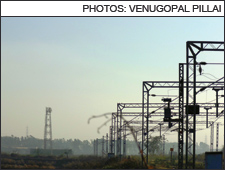 A drastic cramp on year-end bulge to exhaust plan account disbursements, along with the usual fiscal-end hectic efforts to speed up receipts, has helped the central government to end the fiscal with a lower fiscal deficit, says Dr. M.S. Kapadia, Director, Economic Research India Pvt. Ltd.
A drastic cramp on year-end bulge to exhaust plan account disbursements, along with the usual fiscal-end hectic efforts to speed up receipts, has helped the central government to end the fiscal with a lower fiscal deficit, says Dr. M.S. Kapadia, Director, Economic Research India Pvt. Ltd.
The Government of India’s fiscal deficit was placed at Rs.4,899 billion in terms of the provisional data from the Controller General of Accounts (CGA), lower compared to Rs.5,209 billion assessed in Revised Estimates in the Union Budget presented in February last. This was the third year when the provisional deficit turned out to be below RE. The fiscal deficit, which was Rs.264 billion lower than in 2011-12, worked out to 4.9 per cent of GDP against 5.2 per cent estimated in RE. Non-debt receipt exceeded RE by Rs.96 billion. Non-tax revenue receipt was Rs.80 billion excess and non-debt capital receipt around Rs.26 billion more, even as tax receipt fell Rs.10 billion below RE. February and March saw hectic activities to garner money from PSU equity disinvestment. Total disbursement was managed at Rs.214 billion less compared to RE. Non-plan expenditure was around Rs.65 billion below RE, whereas plan account disbursement was Rs.149 billion less than RE.
Fiscal deficit or net borrowing to bridge the gap between disbursements and non-debt receipt was 69 per cent of annual by the end of H1 and 83 per cent by the end of December, much higher than 54 per cent and 74 per cent respectively at these points of time a year ago. However, reflecting the resolve of the finance minister to rein in the debit, the last quarter saw frantic revenue raising on one hand and relatively easily manageable pruning of plan expenditure on the other, which enabled the government to meet its fiscal prudence goals. Revenue deficit was Rs.278 billion below RE and Rs.312 billion less annually. Revenue deficit was 3.6 per cent of GDP against the RE ratio of 3.9 per cent. Last year also saw P. Chidambaram take charge of the finance ministry, in August, from Pranab Mukherjee, who was elevated as President of the country.
About 64 per cent of non-debt receipt was booked during the first three quarters of the year, a little lower than 65 per cent in the corresponding period of 2011-12. The pace of increase in the receipt got enhanced from 14 per cent till December to 17 per cent by the end of the fiscal. Net tax receipt accelerated from 15 per cent increase till December to 17 per cent by the end of the fiscal and non-tax receipt like dividend and interest income from 11 per cent to 13 per cent. Capital receipt was running 51 per cent lower during H1; the decline came down to 6 per cent by the end of December and turned positive by the end of the fiscal following frenzied raising from PSU equity disinvestment particularly in February-March.
|
CENTRAL GOVERNMENT FINANCE: BUILD-UP BY QUARTER END (%)
|
||||
|
Non-debt Receipts
|
Total Expenditure
|
Gross Fiscal Deficit
|
Revised Deficit
|
|
| 2012-13 | ||||
| First Q |
38.8
|
22.1
|
38.9
|
42.0
|
| Second Q |
1.5
|
27.1
|
29.9
|
30.4
|
| Third Q |
23.4
|
21.1
|
13.8
|
9.6
|
| fourth Q |
36.2
|
29.7
|
17.4
|
18.0
|
| Total |
100.0
|
100.0
|
100.0
|
100.0
|
| ` billion |
9,195
|
14094
|
4899
|
3635
|
| 2011-12 | ||||
| First Q |
12.5
|
20.0
|
31.5
|
34.1
|
| Second Q |
27.9
|
25.9
|
22.9
|
22.1
|
| Third Q |
25.0
|
22.8
|
19.4
|
16.3
|
| fourth Q |
34.6
|
31.3
|
26.2
|
27.5
|
| Total |
100.0
|
100.0
|
100.0
|
100.0
|
| ` billion |
7,881
|
13,044
|
5163
|
3946
|
Economic slowdown
Reflecting a slowing economy, the y-o-y increase in corporate tax came down from 51 per cent in Q1 to 12 per cent over H1 and 10 per cent over the fiscal (notwithstanding the March-bulge). Customs duty collection went up from 3 per cent increase during April-July to 11 per cent by end of the fiscal due to improving export. Strangely, even as IIP was weakening, excise duty collection got speeded from 8 per cent during Q1 to 21 per cent by the end of the Q4. Significantly, service tax maintained its y-o-y increase at 30-40 per cent. As in 2011-12, PSU equity disinvestment was concentrated in February-March, which resulted in realisation of proceeds much below potential. Obviously, fiscal consideration overrode economic considerations.
Central government disbursement, which was running merrily at 20 per cent higher till August and 16 per cent over H1, slowed to 11 per cent by December and 8 per cent by end of the fiscal. The distribution of expenditure over the fiscal has improved markedly: the spending till December constituted 70 per cent of the annual and the last month, March, saw around 13 per cent of the annual spend, against 15 per cent during 2011-12 and 18 per cent two years ago.
The y-o-y growth in non-plan expenditure was 12 per cent over the fiscal and 23 per cent during April-August. The containment was more marked in plan account spending which showed 0.5 per cent decline over the fiscal, against 14 per cent rise during H1. Mirroring drastic cancellation of last minute proposals to exhaust allocation, plan account capex dropped 31 per cent and revenue (including grants) disbursements 24 per cent during March, which brought down the cumulative increase to only 8 per cent during the fiscal from 28 per cent till February in plan capex and to one per cent decline from 11 per cent increase in plan revenue expenses during H1 and 4 per cent till February.
In non-plan expenditure, the defence capital outlay of Rs.705 billion exceeded RE by 1 per cent. The last quarter saw capex of Rs.198 billion. Interest payment of Rs.3,120 billion was 2 per cent below RE. In plan expenditure, which was 3 per cent short of RE, under-spending was more marked in Ministry of Power (51 per cent), Ministry of Textiles and Ministry of Micro, Small & Medium Enterprises (20 per cent each), Ministry of Labour and Employment (15 per cent), Ministry of Home Affairs (11 per cent), Ministry of Communication and Information Technology (9 per cent), Ministry of Statistics and Programme Implementation (8 per cent) and Ministry of Health and Family Welfare (7 per cent). Ministry of Railways and Ministry of Road Transport and Highways could exhaust all their allocations.
Trends for 2013-14
In the meantime, gross fiscal deficit shot up 39 per cent to Rs.936 billion in April 2013, as compared to 10 per cent decline a year ago. Total disbursement was 16 per cent more, whereas non-debt receipt was running 39 per cent lower annually during the month.










